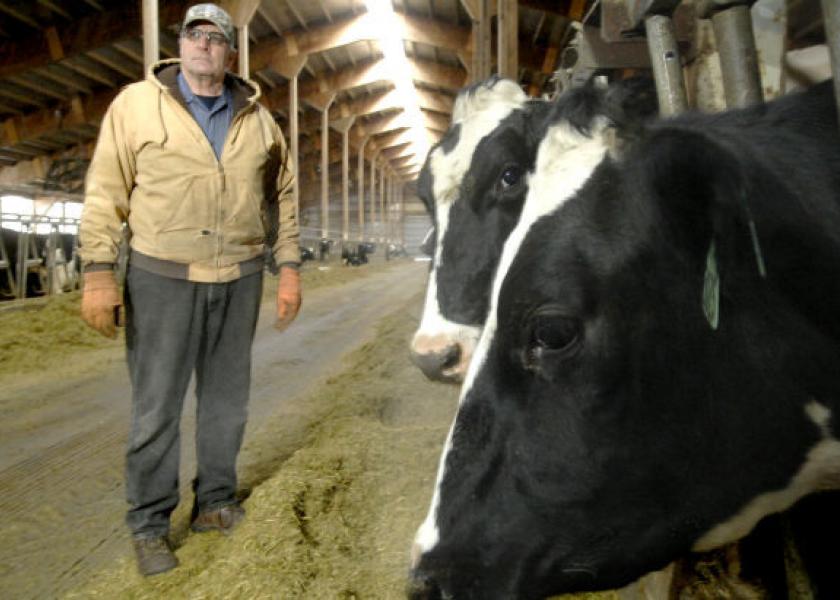Drop in North Dakota Dairy Farms Discouraging to Many

A drop in the number of North Dakota dairy farms — from 350 in 2000 to 91 today — has led to scrutiny of a state law that allows only family members to form farming corporations.
While the rule protects family owned enterprises from corporate entities, farm numbers have dropped so low that the viability of milk-processing facilities in the state has become endangered, according to Doug Goehring, the state's commissioner of agriculture.
Some producers say they would like to follow South Dakota's lead to allow corporate farming in an effort to lure more dairy operators into the state.
"Our dairy industry is hurting terribly," Goehring said.
As a result, Goehring proposed to allow exceptions to North Dakota's non-corporate farming law for dairies, swine operations and feedlots to a full room of legislators during the first week of the legislative session, The Bismarck Tribune reported.
"If the legislature wants to take this up and the ag community wants to push it, then I would think it probably would happen (this session)," said Goehring, adding producers need to own the issue in order to facilitate the change.
In 2000, there were about 49,000 dairy cows. Now, there are about 16,000 dairy cattle, according to Goehring. For swine operations, the headcount has decreased from 18,500 pigs in 2000 to 13,900. Beef cattle numbers have remained more stable, and a new slaughter plant scheduled to come online in Aberdeen, South Dakota, next year has more ranchers interested in starting feedlots.
"Dairy has probably been the one that has been the most hurt and in more dire need. We just continue to see declines," said Goehring, adding that out-of-state producers see benefits to moving their operations to North Dakota, but they would need to corporate to make it financially feasible.
Jerry Messer, who raises dairy cattle on Beaver Creek Ranch in Richardton, said that when South Dakota tweaked its laws to allow multiple dairy investors instead of just one family, the state became successful at recruiting dairies.
A vibrant dairy industry also benefits corn growers by allowing them to diversify and make more money, according to Messer.
"In North Dakota, corn goes to two places: It either goes to the ethanol plants or on a train to another market," said Goehring, adding that grain farmers want another option for their grain. "For every 3,300 bushels of feed that is consumed by a cow or pig, that means one less rail car going out of the state."
One milk processing facility in central North Dakota has been operating at a 600-cow-a-day deficit, forcing it to import milk into the state.
"When operations have to start doing that, plants start closing doors," Goehring said. "We don't have enough cows in central North Dakota anymore."
Goehring gave the example of a 25-partner outfit along the border. Farmers partnered with a dairy operation, providing feed while the one family operated the dairy. The dairy wasn't in competition with the farmers for land because it was content to allow others to grow feed while it did what it does best — manage the animals.
"I think it's those type of structures that seem appealing and seem to be working," Goehring said.
Kenton Holle, of Northern Lights Dairy of Mandan, agreed there is room for expansion of the industry.
"I think that there's a real possibility in North Dakota to see some livestock industries expand," said Holle, adding the adoption of current laws governing corporate farming would help.
Holle said he did not know of any dairy processing plants importing out-of-state milk. He said he thinks milk produced in the state now is adequate to keep them running.
"I think that's the key to it right there," Holle said of partnerships between dairies and farmers growing feed crops. If a law change were to be proposed, he says there should be a clause prohibiting large producers from buying up large amounts of land to plant their feed.
Producers need the ability to pool resources because dairy operations cost so much, according to Goehring, who said an operation often needs to be milking 600 to 800 cows to break even and a 1,600-head dairy operation takes several million dollars to start.
"Most farmers don't have that kind of money sitting around," he said, and many banks won't lend it to a single investor.
"Because our state has been primarily grain production . lenders are not very familiar with animal agriculture. It's hard for them to understand the ebbs and flows that exist in the livestock industry, and they have more apprehension about lending," he said.
Messer, who is chairman of the Midwest Dairy Association and a member of the North Dakota Dairy Promotion Commission, said, with much of its new oil wealth, North Dakota is in a good position to recruit more dairies.
He suggested creating an investment fund for those with oil royalties who want to support North Dakota agriculture. He said the investors would get tax write-offs and the fund would supplement the programs offered by the Bank of North Dakota for starting and growing farmers.







